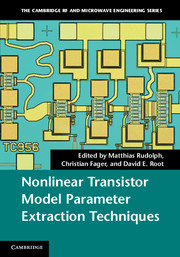Book contents
- Frontmatter
- Contents
- List of contributors
- Preface
- 1 Introduction
- 2 DC and thermal modeling: III–V FETs and HBTs
- 3 Extrinsic parameter and parasitic elements in III–V HBT and HEMT modeling
- 4 Uncertainties in small-signal equivalent circuit modeling
- 5 The large-signal model: theoretical foundations, practical considerations, and recent trends
- 6 Large and packaged transistors
- 7 Nonlinear characterization and modeling of dispersive effects in high-frequency power transistors
- 8 Optimizing microwave measurements for model construction and validation
- 9 Practical statistical simulation for efficient circuit design
- 10 Noise modeling
- Index
Preface
Published online by Cambridge University Press: 25 October 2011
- Frontmatter
- Contents
- List of contributors
- Preface
- 1 Introduction
- 2 DC and thermal modeling: III–V FETs and HBTs
- 3 Extrinsic parameter and parasitic elements in III–V HBT and HEMT modeling
- 4 Uncertainties in small-signal equivalent circuit modeling
- 5 The large-signal model: theoretical foundations, practical considerations, and recent trends
- 6 Large and packaged transistors
- 7 Nonlinear characterization and modeling of dispersive effects in high-frequency power transistors
- 8 Optimizing microwave measurements for model construction and validation
- 9 Practical statistical simulation for efficient circuit design
- 10 Noise modeling
- Index
Summary
Designing microwave circuits today means relying on numerical circuit simulation. While not a substitute for one's own skills, knowledge, and experience, a designer must be able to count on the adequacy of circuit simulation tools to accurately simulate the circuit performance. Circuit simulators themselves are generally up to the challenge. However, there is a perpetual quest for good transistor models to use with the simulator, because models are usually the limiting factor in the accuracy of a simulated design. This is due to the continuous evolution of transistor technology, requiring the models to keep up, and also to the increasing demands placed on the models to perform with respect to wider classes of signals, operating conditions (e.g., temperature), and statistical variation. Circuit designers therefore often face the challenge of adapting the models that are provided with simulators to better describe the actual transistor that is being used in the design. This is achieved by characterizing the transistor, mainly by measurement, but also by electromagnetic and/or thermal simulation. Finally, model parameter values must be extracted from this data before the model can be used at all in a design.
As transistor modeling is a key to circuit design, many publications are available on the models for any type of transistor, ranging from model documentation in simulator products, to application notes and scientific papers in technical conferences and journals; but it seems that much less is published on how the respective model parameters can be determined.
Information
- Type
- Chapter
- Information
- Nonlinear Transistor Model Parameter Extraction Techniques , pp. xiii - xivPublisher: Cambridge University PressPrint publication year: 2011
